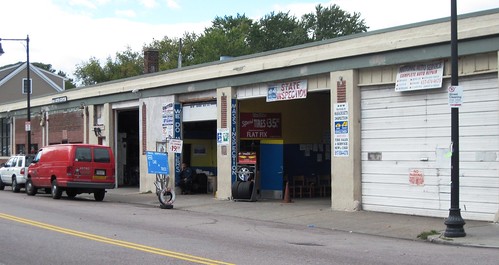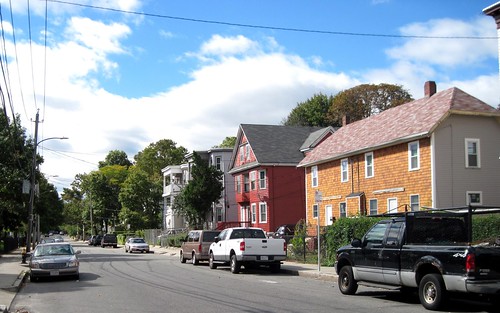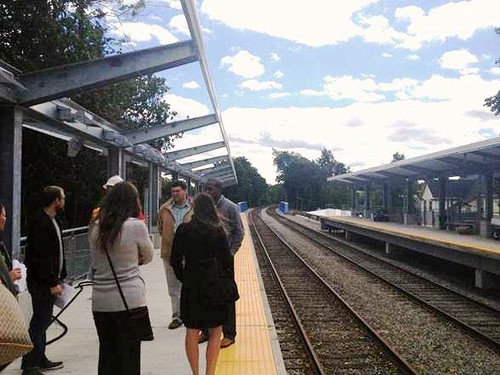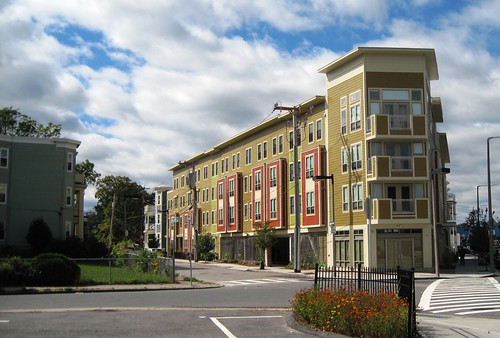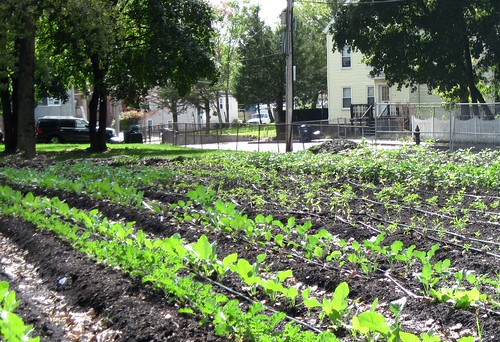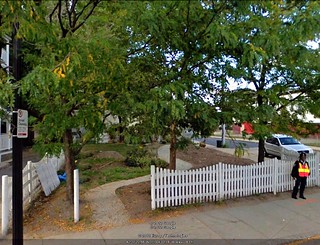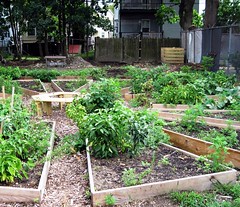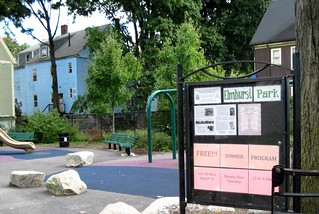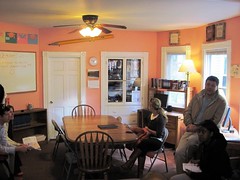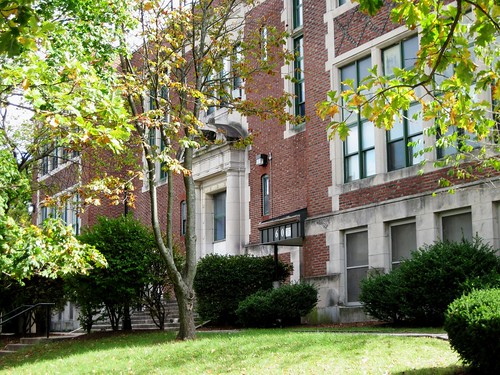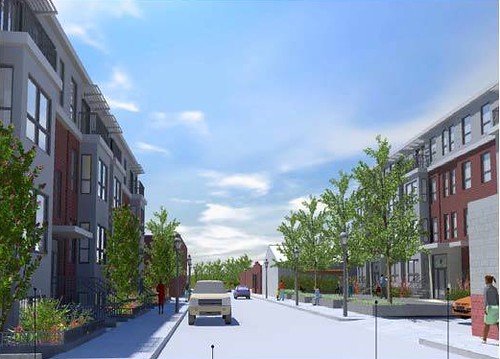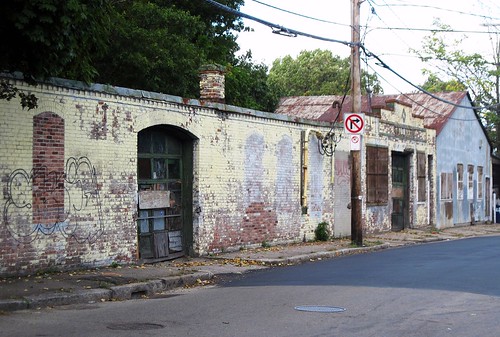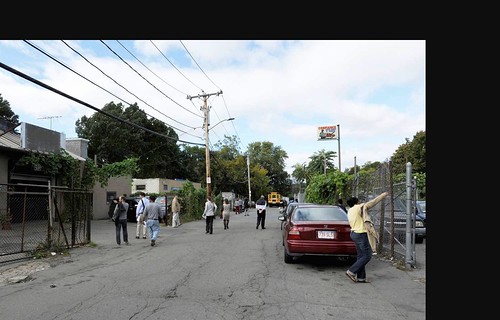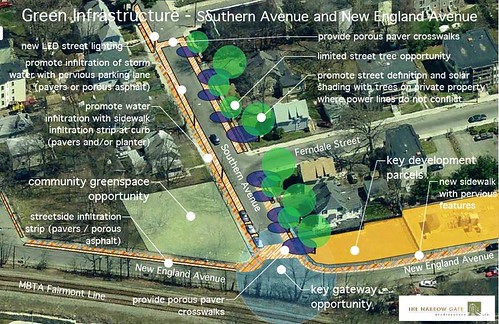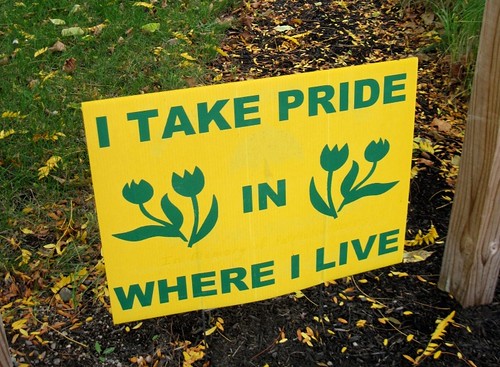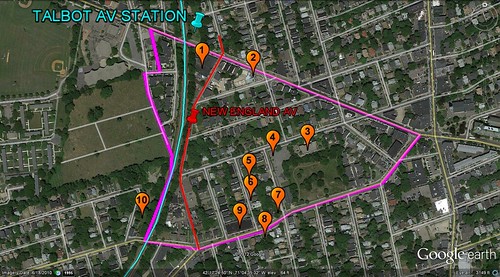A low-income community taps homegrown leadership for a brighter future

Posted October 17, 2012 at 2:55PM
The photo just above shows an auto repair shop in the heart of Boston’s Codman Square neighborhood, about six miles south of downtown. The shop has residential development on all sides and, if you’re thinking about community improvement, your first thought might be that it doesn’t belong there, and your second might be to consider how to be rid of it.
Except, in this case, you couldn’t be more wrong. Within the next year, the shop will be one of the community's most visible green assets. It will have a green roof to absorb stormwater and reduce the need for air conditioning, and solar panels to generate its electricity through renewable energy. Its owner, Larry Dossantos, is deeply committed to a rejuvenated, greener community, and he attended and made significant positive contributions to the community planning meetings held there earlier this month. In actuality, the shop is providing jobs, environmental stewardship, and long-term dedication to the neighborhood. The worst thing the community could do would be to turn its back on this kind of locally based leadership and green entrepreneurship.
Not all business owners in all neighborhoods are as enlightened or benign, of course, and figuring out whether and how to have different kinds of businesses, including sometimes messy ones, in a community alongside homes, churches, and schools is not always easy. But Codman Square is no ordinary neighborhood.
As I wrote in my previous article, the nonprofit, community-based Codman Square Neighborhood Development Corporation, the Local Initiatives Support Corporation, and the Natural Resources Defense Council are partnering with the community (including, significantly, a group called Talbot Norfolk Triangle (TNT) Neighbors United) to help it realize its goal of a more sustainable future. The partners are using LEED for Neighborhood Development as a planning tool, and by applying it have compiled a detailed assessment of the TNT district’s current strengths and opportunities for improvement.
The new rail transit station
The most striking improvement, of course, is the neighborhood’s new commuter rail station at Talbot Avenue, providing far better access than residents have previously had to jobs, services and amenities in downtown Boston and points along the way. (Codman Square residents are also getting a second station, a bit to the north in an area called Four Corners.) This has been a long time coming: indeed, neighborhoods along the Fairmount transit corridor stretching southwest of downtown Boston had enjoyed local train service for over 100 years until it was discontinued in 1944. When service was partially restored in the early 1980s, no stops were provided along an eight-mile stretch that included Codman.
 Bit by bit, community groups began to make progress with the local transit authority to restore service to the bypassed neighborhoods. The Dudley Street neighborhood (whose own citizen-led revival has been inspiring) initially led the way, and the corridor gained two restored stations in the 1990s. Subsequently, the Greater Four Corners Action Coalition worked with the authority’s advisory board to envision the corridor as a fully restored transit line, integrated with the rest of Boston’s system.
Bit by bit, community groups began to make progress with the local transit authority to restore service to the bypassed neighborhoods. The Dudley Street neighborhood (whose own citizen-led revival has been inspiring) initially led the way, and the corridor gained two restored stations in the 1990s. Subsequently, the Greater Four Corners Action Coalition worked with the authority’s advisory board to envision the corridor as a fully restored transit line, integrated with the rest of Boston’s system.
Four community development corporations along the Fairmount Line (including the Codman Square NDC) formed a collaborative to advocate and plan a compelling vision, hiring Boston’s Goody Clancy architects to help them create what became a widely heralded, award-winning plan for “Boston’s Newest Smart Growth Corridor.” In 2005, the state of Massachusetts committed $43.5 million to the project, which ultimately resulted in the construction of several new stations on the Fairmount Line, including one at Talbot Avenue that will serve the Talbot Norfolk Triangle.
The Codman Square NDC also commissioned a master development vision for the Triangle, which was delivered by the firm SAS Design in 2007. That plan contains several concepts that have since been initiated, although the NDC’s thinking has evolved in the last five years. The current exercise represents a fresh look at the neighborhood, building off of these previous planning exercises.
New green projects in the neighborhood
Among projects already realized, the Levedo Building is one of the neighborhood’s new green highlights. Completed last year by the NDC on four previously vacant, adjacent parcels a block and a half from the new transit station, the Levedo now provides 24 high-quality affordable homes, a playground, and commercial space. The building has been certified LEED gold on the strength of a number of advanced green features, including solar panels sufficient to supply 25 percent of the building's energy needs, a cistern that collects enough rainwater to provide all needed irrigation for the Levedo's landscaping, a number of additional features to support energy efficiency, the use of sustainably grown wood and, of course, the close proximity to transit including three bus lines as well as the new rail service.
The neighborhood also has some great new green and public spaces, starting with a small (half-acre) urban farm, managed by Boston’s ReVision Urban Farms and assisted by a community advisory board and youth volunteers.
Next up are two additional new green spaces, one a pocket park and the second a smaller community garden, introduced on previously vacant lots in the neighborhood, with more to come. The smaller park spaces have been championed by The Boston Project Ministries, a faith-based organization in the TNT area “with a passion for seeing renewal in urban neighborhoods.” The Boston Project was founded by Paul and Glenna Malkemes; Paul also leads the community organization Talbot Norfolk Triangle Neighbors United.
Here’s how the Boston Project expresses its commitment to additional green space in the neighborhood:
“A multi-site urban garden will transform the TNT neighborhood by creating a walkable route that connects green spaces in the community. Planned play areas, passive parks, urban gardens and orchards are a few of the projects neighbors want to see come to fruition! A multi-site urban garden will:
- Preserve urban green space and provide balance in an area marked by active housing development. TNT has 300 housing units (source: 2000 census), with plans for a potential 100+ additional units in the next 2-4 years.
- Promote physical activity and neighbor interaction. Neighbors of all ages will be able to relax, converse, play and learn in new open, green areas.
- Encourage healthier eating. The community garden will encourage and facilitate eating fresh, local food.
- Provide learning opportunities. Collaborations with urban greenspace groups and local schools will bring learning opportunities to our neighborhood.
- Engage youth in employment opportunities. Environmentally-focused internships for teens will provide youth opportunities to learn skills to equip them for work in the green economy while furthering the goals of the TNT Greenspace Master Plan.
- Inspire community pride!”
The organization has a ten-year plan for converting small, publicly owned vacant lots scattered around the TNT area into green "islands" to be enjoyed by the community. These will benefit not only current residents but also the 100 new households the neighborhood is expected to see as a result of the new transit station.
With that kind of commitment and enthusiasm, it should not surprise that the Boston Project was also a driving force behind the creation of Elmhurst Park, a new children’s park in the community. The Project was fortunate to be joined in that effort by, in addition to other neighborhood, philanthropic and municipal partners, the Trust for Public Land, which has long had a terrific program for city parks, led by Peter Harnik.
I can’t say enough good things about the Boston Project Ministries, which among many super-impressive initiatives offers a free, pleasant and safe drop-in center where youth can come and go at their leisure to do homework or enjoy fellowship (see photo). (Paul and his family live directly above the center.) The work of this organization strikes me as exactly the kind of thing that Eric Jacobsen might have had in mind when writing his new book The Space Between about the intersection of cities and spiritual practice. As I wrote some time back in the context of Miami’s Little Havana, neighborhoods with able champions benefit greatly from their commitment and work.
Looking toward future development
There are also some very promising future projects in the works, again sponsored by the Codman Square Neighborhood Development Corporation. The Whittier Apartments, for example, occupy the historic building that once housed the Whittier School. I am always troubled when neighborhood schools are abandoned, especially in a neighborhood such as this one with so much potential for recovery. But, if you can’t have the school, re-using a historic building to supply quality affordable housing is a great way to go.
The old school building was converted to apartments some years ago under state ownership, and has been managed by the Codman NDC under contract since the mid-1980s. After years of deferred maintenance due to insufficient operating expenses, the building will now undergo substantial rehabilitation. When finished, the 14 units in the Whittier will be fully updated with new green building features, while maintaining the building’s historic character and deep affordability for residents, none of whom will be displaced.
Meanwhile, adjacent to the Whittier property is what is now a paved vacant lot and neighborhood eyesore. The NDC acquired this property last year and is planning construction of three new wood frame buildings in a style compatible with the architecture of neighboring homes. 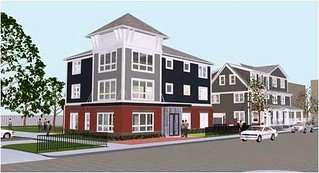 Collectively, they will provide 13 new homes, a community room, management office, and common areas. All systems for this project will be designed and installed to meet Energy Star and LEED green building standards. The grounds between the new buildings and the Whittier will be landscaped in a way to unify the two adjacent sites while providing play areas for kids.
Collectively, they will provide 13 new homes, a community room, management office, and common areas. All systems for this project will be designed and installed to meet Energy Star and LEED green building standards. The grounds between the new buildings and the Whittier will be landscaped in a way to unify the two adjacent sites while providing play areas for kids.
All units will be affordable. The new homes will be available to families earning 60 percent or less of area median income; the rehabbed Whittier units will be made available to households earning 30 percent or less of AMI.
In addition, directly across the street from the new transit station will be a new project called Talbot Commons. Phase one will be a mixedâ€use project of 26 affordable co-op homes, 4000 square feet of commercial space, and 11,000 square feet of open space on an assembly of six parcels. The project, which will be designed to LEED green standards, will comprise two new buildings along with adaptive reuse of an existing building. Assuming the first Phase is successful, there is a concept for a second phase to be built on nearby vacant and underutilized lots.
The importance of the leadership of the NDC in all these projects cannot be overstated. This community-based organization is on the ball. The Boston Redevelopment Authority and Massachusetts Bay Transit Authority also deserve credit, and little of it would be happening without financial investment from a range of entities including LISC, Enterprise Community Partners, and NeighborWorks America.
Reviving a deteriorated strip
As noted in my previous article, the LEED-ND technical team assisting the neighborhood identified a four-block stretch of New England Avenue, running directly south from the transit station and the soon-to-be Commons project to the bottom of the TNT “Triangle,” as a particular opportunity for green development that would serve the neighborhood. Today, New England Avenue looks very much like a relic from an era in which industry (in this case small industry) sought to locate by the railroad tracks but has long since fled, gone out of business, or is hanging on with substandard properties, leaving a decayed mess. To make matters worse, it has become a popular cut-through for sometimes heavy automobile traffic, as well as a popular route for kids to walk home from school despite the absence of usable sidewalks.
It’s not a good situation, especially when you consider how prominent that stretch of road is going to become as the transit station gains ridership. What you want to support transit and the right kind of transit-oriented development is a high degree of walkability; the last thing you want is a sketchy, heavily traveled road with no amenities for people and no safe place to walk.
Goody Clancy architects assisted the recent planning meetings and presented some before and after visions of New England Avenue, just to illustrate the range of possibilities. (If a project like this were implemented, the scale and architectural design would be chosen by the neighborhood partners; these are just illustrative ideas.)
In the before-and-after sequence you see above, the improvements include, in addition to new homes and shops, tree-lined sidewalks buffered from traffic by on-street parking; textured crosswalks to signal pedestrian-priority space, textured street surface to calm traffic; and architectural definition that creates a sense of place.
Adding more environmental quality to the corridor, the architectural firm the Narrow Gate suggested to the community meeting that the neighborhood adopt a range of green streets practices, including liberal use of porous pavers to absorb and filter rainwater before it becomes polluted runoff; many more shade trees along the streets; energy-efficient street lighting; and new community green space. Better stormwater management, in particular, was identified as an opportunity area during the LEED-ND evaluation.
An opportunity for deeper green retrofits
It was the feeling of the evaluation team that, if the neighborhood wanted to go all in for sustainability, one of the most promising additional areas would be deep-green building and infrastructure retrofits for energy efficiency. This could probably only be accomplished with substantial philanthropic, government, and/or corporate assistance, but building-to-building and street-to-street energy audits and efficiency installations, coupled with a deeper commitment to on-site renewable power (the neighborhood already has some great precedent with the auto shop and the Levedo Building), and perhaps a pilot project to test highly efficient district energy systems for portions of the neighborhood, could move the TNT district to a world-class showcase of green ambition and performance.
To bring these deeper green benefits to a traditionally underserved community, rather than only in high-end resorts and such, and one-off expensive homes, would be so great. Think of the money saved on energy bills for low-income families, for example. I hope someone undertakes a feasibility study to at least scope the issues and make some determination of costs and benefits. Coupled with all the other great initiatives there, why not a Codman Square Innovation District? The neighborhood already has the leadership, vision, and a foundation of sensitive green investors and entrepreneurs. Adding a full range of ambitious environmental benefits to an inclusive and diverse, mixed income future for the community could be truly exciting.
In addition to the local partners, many thanks to Madeline Fraser-Cook of LISC's Green Development Center and NRDC's Jessica Millman and Marissa Ramirez for their dedication to this great work.
Key to location of projects and opportunities discussed in this article:
- Talbot Commons
- Levedo Building
- Whittier Apartments
- New homes
- Elmhurst Park
- Boston Project Ministries
- Pocket park
- Community garden
- Auto repair shop, going green
- Urban farm
(in addition, the rail tracks are marked in blue. New England Avenue is marked in red.)
Codman Square revitalization series:
- Signs of inspiration and resilience in an inner-city neighborhood (photo essay)
- How to use LEED-ND to improve an older neighborhood
Related posts:
- The Space Between: caring for cities as an expression of faith (October 12, 2012)
- Retrofitting inner-city neighborhoods for energy efficiency (October 1, 2012)
- A remarkable grassroots revitalization matures and thrives in Boston (March 26, 2012)
- How parks can help revitalize distressed neighborhoods (March 16, 2011)
- Distressed city neighborhoods need green investment for community, environment (March 19, 2010)
- Boston’s Asian CDC builds community from the ground up (September 1, 2009)
- Great work from Boston-based smart growth architects (May 15, 2008)
Move your cursor over the images for credit information.
Please also visit NRDC’s sustainable communities video channels.
